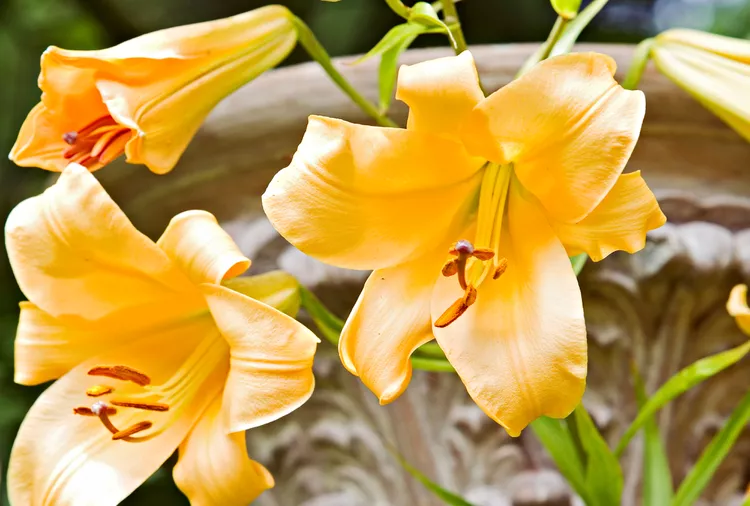Lilies are beautiful perennial plants to grow in the garden with their stunning flowers that come in an array of colors. According to the North American Lily Society, lilies are classified into nine categories or divisions, based on their growing needs, flower shape, and style. Here are 7 of the best types of lilies to grow for their unique characteristics such as flower colors, plant height, and whether they thrive in full sun or can grow in part shade.
What Are Lilies?
The word "lily" can refer to plants that are true lilies and plants that belong to another genus. For example, daylilies are popular perennials that belong to the genus Hemerocallis. Despite having lily in the name and having flowers that resemble lilies, daylilies are not true lilies.
True lilies are part of the genus Lilium. These plants grow from large scaly bulbs, producing strappy leaves along a single unbranched stem. The first flower buds to open are lower on the stem and have six petals and six anthers, making true lilies easy to identify when you know what to look for.
Many plants are often referred to by their common name, making them easier to remember and pronounce. But sometimes one common name can refer to various different plants or the common name can be misleading. The best way to ensure that you're talking about the correct plant is to learn the botanical or scientific name of the plant.
Best Types of Lilies to Grow
Whether you're a beginning gardener, love fragrance, want to grow a cut flower garden, or only have indoor space, there is a lily for you.
Best Lilies for Beginners: Asiatic Hybrids
Asiatic hybrids are actually derived from several lily species that originated in Asia. These hybrids are ideal for beginner gardeners because they are among the easiest lilies to grow. They bloom in the summer months but are not fragrant. Choose from an array of solid colors and even two-tone flowers such as 'Purple Rain' (shown above), with white petals that have a dark purple inner ring.
Growing Conditions: Full sun to part shade and moist, well-drained soil
Height: 2-3 feet
Zones: 4-8
Best Fragrant Lilies: Oriental Hybrids
If you’re looking for lilies that emit a strong fragrance, plant Oriental hybrid varieties. These can be slower growing, so you can expect blooms in the middle to late summer. One of the most familiar Oriental lilies is 'Stargazer,' which is often used in flower arrangements. 'Stargazer' lilies have white outer petals with a splash of magenta in the middle. Another popular Oriental lily is 'Casa Blanca' (shown above), an all-white lily that almost seems to glow in the moonlight.
Growing Conditions: Full sun and moist, well-drained, acidic soil with plenty of mulch
Height: 2-5 feet, depending on variety
Zones: 4-9
Best Tall Lilies: Trumpet Hybrids
This group of lilies (also known as Aurelian hybrid lilies) gets its name from the tubular shape of their huge, fragrant flowers. However, some varieties of trumpet lilies flare open more widely into star or bowl shapes, such as the 'Golden Sceptre' shown here. Often reaching four or more feet in height, these tall lilies benefit from staking to keep them upright under the weight of their blooms. Flowers appear in July and August.
Growing Conditions: Full sun and moist, well-drained soil
Height: 4-6 feet, depending on variety
Zones: 4-8
Best Lilies for Cut Flowers: Orienpet
Orienpet lilies are hybrids of trumpet and Oriental lilies. They boast the big flowers of Oriental lilies and the height of trumpet lilies. Depending on the variety, flowers can be a range of pinks, reds, orange, yellow, or even white flowers. Some are even bicolored, like 'Altari' shown here, which has white outer petals and bright pink flames in the middle of each petal. Orienpets typically bloom from mid- to late summer. These types of lilies make excellent cut flowers because their beautiful blossoms can last six weeks to two months.
Growing Conditions: Full sun and moist, well-drained soil
Height: 3-8 feet, depending on variety
Zones: 4-9
Best Lilies for Shade: Canada Lilies
Don't let shade stop you from growing lilies. Canada lilies (Lilium canadense) can handle more shade than other types of lilies and are also a little more cold-hardy. These species of lilies bloom during the summer months, producing flowers that typically have yellow or orange petals, sometimes speckled. Each stem has anywhere from five to 20 flowers, though the blooms aren't as large as their exotic cousins. And the blossoms hang downward toward the ground.
Growing Conditions: Dappled to part shade and cool, moist soil
Height: 4-8 feet
Zones: 3-9
Best Long-Blooming Lilies: LA Hybrids
LA hybrids are a mixture of Easter lilies and Asiatic lilies, but bigger in size and don’t give off much of a scent. These types of lilies will give you several weeks of colorful, upward-facing flowers to admire in your garden or a vase. The flowers attract pollinators, including bees, butterflies, and hummingbirds.
Growing Conditions: Full sun to part shade and moist, well-drained soil
Height: 4-6 feet
Zones: 5-8
Best Lilies to Grow Indoors: Easter Lilies
Easter lilies are the best type of lilies to grow indoors in containers. Easter lily hybrids have fragrant, trumpet-shaped, white flowers. Place them in an area of your home with lots of bright light and make sure the soil stays moist.
Another type of lily you can grow indoors is the Formosa lily with tubular-shaped white flowers with a sweet scent. These thrive with plenty of bright light. These varieties are sold at nurseries and plant shops in the springtime, typically around Easter. When making your selection, choose plants that have several closed buds because the blooms only last for a few days.




















